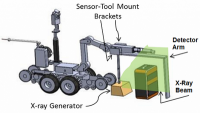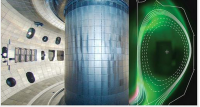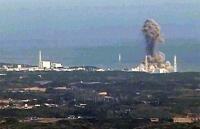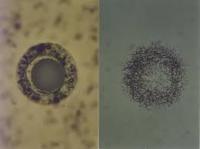-
Bomb detectors fraudster ordered to pay £1.2 million
Gary Bolton, a convicted fraudster who made millions selling fake bomb detectors around the world, has been ordered by a court to pay more than £1 million. In August 2013 Bolton, 49, from Chatham in Kent, was sentenced to seven years in jail for the sale of more than 1,000 useless detectors that he claimed could track down bombs, drugs, ivory, and money. Bolton was one of several defendants convicted for their part in fake bomb detector scams. In 2013, James McCormick, a British businessman, was convicted of having made millions in profits from selling fake bomb detectors to Iraq, Georgia, and several other countries.
-
-
Airport X-ray screening systems comply with health and safety radiation exposure standard

Machines that use advanced X-ray imaging technology to screen airport passengers comply with radiation exposure limits set by the American National Standards Institute/Health Physics Society (ANSI/HPS), says a new report from the National Academies of Sciences, Engineering, and Medicine. The report also finds that the machines adhere to the recommended safety mechanisms described in the ANSI/HPS standards to prevent overexposure to radiation in the event of a mechanical failure or deliberate tampering.
-
-
Clothing that guards against chemical warfare agents
Recent reports of chemical weapons attacks in the Middle East underscore the need for new ways to guard against their toxic effects. Scientists report that a new hydrogel coating that neutralizes both mustard gas and nerve agent VX. It could someday be applied to materials such as clothing and paint.
-
-
TSA agents find record number of guns in carry-on luggage at airports
TSA agents discovered 67 guns in carry-on luggage during the week which ended 17 September. The tally for the week broke an earlier record of 65 firearms found during one week in May 2013. TSAofficers found nearly 1,900 firearms in carry-on luggage between 1 January and 31 August 2015. This year is thus on track to see a 28 percent spike in the number of firearms found compared to the 2,212 guns — an average of about 40 a week — discovered by TSA agents in 2014.
-
-
X-ray Scanning Rover offers a new level of explosives detection

From conflict zones to airports to sporting events, bombs pose dangers for innocent civilians as well as the bomb technicians who regularly risk their lives to investigate suspicious objects and render the devices safe. Technology solutions can help first responders to see hidden dangers. To this end, the DHS S&T’s First Responders Group (FRG) is developing the X-Ray Scanning Rover (XSR) to be a responder’s eyes. It quickly and accurately scans packages and bags for leave-behind improvised explosive devices (LBIED) while keeping responders out of harm’s way. Unlike most existing scanners that use pulsed X-ray energy for detection, the XSR robot features a continuous, fan-shaped operating X-ray beam, permitting a higher degree of penetration through dense packaging.
-
-
Small-scale nuclear fusion may be a new energy source

Nuclear fusion is a process whereby atomic nuclei melt together and release energy. Because of the low binding energy of the tiny atomic nuclei, energy can be released by combining two small nuclei with a heavier one. Fusion energy may soon be used in small-scale power stations. This means producing environmentally friendly heating and electricity at a low cost from fuel found in water. Both heating generators and generators for electricity could be developed within a few years, according to researchers.
-
-
Fukushima disaster was preventable: Study

The worst nuclear disaster since the 1986 Chernobyl meltdown never should have happened, according to a new study. Researchers distilled thousands of pages of government and industry reports and hundreds of news stories, focusing on the run-up to the Fukushima Daiichi disaster in 2011. They found that “arrogance and ignorance,” design flaws, regulatory failures, and improper hazard analyses doomed the coastal nuclear power plant even before the tsunami hit.
-
-
Testing radiation detection systems in harsh conditions
Researchers from five laboratories and a private company recently spent two days in blistering 100 degree heat testing radiation detection technologies amidst cargo containers. The fifteen researchers demonstrated the feasibility of using gamma-ray and neutron imaging detectors to identify radioactive materials using the Lawrence Livermore National Laboratory’s (LLNL) cargo container stack testbed.
-
-
UN inquiry to determine who is responsible for chemical attacks in Syria
Russia has withdrawn its objections to a UN investigation into identifying the culprits responsible for chemical attacks in Syria, allowing a probe to begin, UN diplomats said Thursday. For the last two years, Russia had insisted that a series of UN investigative teams sent to Syria would be limited to finding out whether or not chemical weapons had been used, but would be barred from identifying who was responsible for launching them.
-
-
Inspired by butterfly wings, scientists design a new gas sensor
The unique properties found in the stunning iridescent wings of a tropical blue butterfly could hold the key to developing new highly selective gas detection sensors. The ground-breaking findings could help inspire new designs for sensors that could be used in a range of sectors, including medical diagnostics, industry, and the military. At present, reliable and cost-effective sensors for detection of small but meaningful gas leaks in a multitude of industrial processes remain an unmet environmental, health, and safety goal.
-
-
Upholding disarmament agreements with engineering
Arms control agreements face a problem: how to ensure that countries with nuclear weapons abide by disarmament agreements. The linchpin of these agreements is being able to verify that the signers are following the rules — but the trick is for both sides, or a third party, to be able to police weapons in a way that doesn’t give out too much information about them, for example, how these weapons were built. An MIT project, called Zero Knowledge Warhead Verification, tackles this problem with a beam of light, a scrambler, and a detector.
-
-
Mighty Saber demonstrates post-nuclear detonation technical forensics capabilities
In late 2013, a team of more than fifty scientists from across the U.S. laboratory and industrial complex began preparing for Mighty Saber with the goal of demonstrating and evaluating post-detonation technical nuclear forensics capabilities following a simulated detonation of a nuclear device in an urban environment. Mighty Saber, which ran from 27 July to 21 August 2015, successfully met each of its objectives, including demonstrating U.S. government post- detonation nuclear forensics processes; the value of prompt diagnostics data provided by the Discreet Oculus ground-based sensor network; and how prompt diagnostics complements radiochemistry in providing a robust post-detonation nuclear forensics capability.
-
-
Cleaning explosives pollution with plants
Biologists have taken an important step in making it possible to clean millions of hectares of land contaminated by explosives. The researchers have unraveled the mechanism of TNT toxicity in plants, raising the possibility of a new approach to explosives remediation technology. TNT has become an extensive global pollutant over the last 100 years and there are mounting concerns over its toxicity to biological systems.
-
-
Radioactive contaminants found in coal ash from all three major U.S. coal-producing basins

A new study has revealed the presence of radioactive contaminants in coal ash from all three major U.S. coal-producing basins. The study found that levels of radioactivity in the ash were up to five times higher than in normal soil, and up to ten times higher than in the parent coal itself because of the way combustion concentrates radioactivity. The finding raises concerns about the environmental and human health risks posed by coal ash, which is currently unregulated and is stored in coal-fired power plants’ holding ponds and landfills nationwide.
-
-
The history of biological weapons use
Few comprehensive, definitive histories of biological warfare have been written, many events reported in the literature never happened, and few details are available about some uses of biological weapons which most certainly did occur. A new review of the literature on actual and alleged instances of biological warfare finds that the incidence of illicit biological agent use has been greater than many people may realize, even as the effects have been relatively limited.
-
More headlines
The long view
Keeping the Lights on with Nuclear Waste: Radiochemistry Transforms Nuclear Waste into Strategic Materials
How UNLV radiochemistry is pioneering the future of energy in the Southwest by salvaging strategic materials from nuclear dumps –and making it safe.
Model Predicts Long-Term Effects of Nuclear Waste on Underground Disposal Systems
The simulations matched results from an underground lab experiment in Switzerland, suggesting modeling could be used to validate the safety of nuclear disposal sites.
